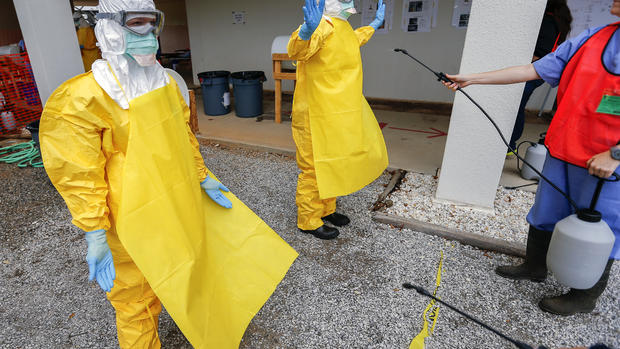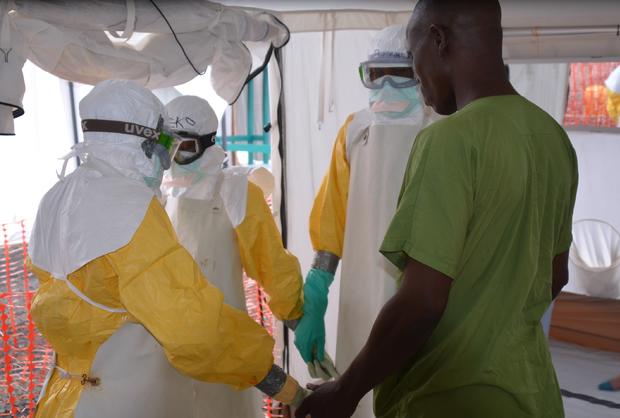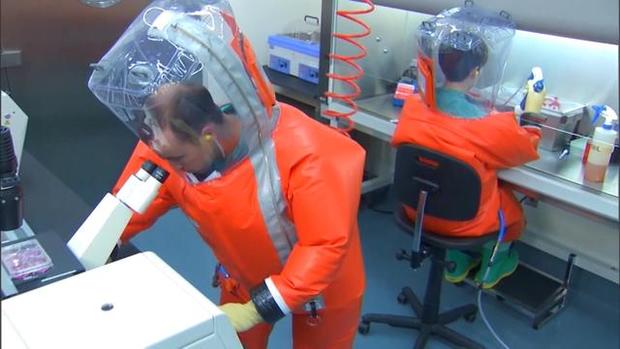Top health stories of the year
Health stories made headlines around the world this year, from the unprecedented Ebola outbreak to the growing use of medical marijuana, the uproar over Dr. Oz, and perennial concerns like diet and exercise. There were some promising breakthroughs, surprising scares and trends that had millions of people talking.
Click through for our look at the most important and most talked-about health stories of 2014.
Ebola in the U.S.
This year the U.S. health care system was faced for the first time in history with the care of Ebola patients. In August, missionary health care workers Dr. Kent Brantly and Nancy Writebol were transported from Liberia and to Emory University Hospital and became the first Ebola patients successfully treated on U.S. soil.
Fear spread even faster than the virus after 43-year-old Thomas Eric Duncan, a Liberian man visiting Dallas, got sick in late September. He was eventually admitted to Texas Health Presbyterian Hospital after having acute symptoms of the virus for a number of days.
Shortly after Duncan's death, two nurses who treated him also tested positive for Ebola. They both recovered, but the cases called to question whether U.S. hospitals are, in fact, Ebola-ready.
Then in October, Dr. Craig Spencer tested positive for Ebola after returning to New York City from Guinea, where he volunteered with Doctors Without Borders. Before he developed symptoms and checked into Bellevue Hospital, he reportedly took three subways, ate at a popular restaurant and visited public places including a park and bowling alley, but no one else caught the virus. Public alarm prompted tougher quarantine measures against those like nurse Kaci Hickox who had contact with Ebola patients.
A handful of other health care workers and a journalist infected in West Africa were treated at specialized U.S. hospitals and most survived with the help of experimental drugs and supportive care.
Click here for more of the top stories.
Ebola in West Africa
This year, three West African countries found themselves at the center of the biggest public health crisis the world has seen in decades. Since the Ebola outbreak was first reported in March, the deadly disease has swept through Liberia, Sierra Leone and Guinea, killing more than 7,500 people and sickening nearly 20,000.
International aid was slow to mobilize, allowing the epidemic to spiral out of control.
The virus tore through villages without adequate medical facilities where families cared for the sick at home and then buried the still-infectious bodies of the dead without proper precautions.
Ebola is a hemorrhagic virus that causes flu-like symptoms including fever, intense weakness, muscle pain, headache and sore throat. These are followed by vomiting, diarrhea, rash, impaired kidney and liver function, and sometimes internal and external bleeding. The Ebola virus is transmitted only through direct contact with bodily fluids from a sick patient.
International efforts are underway to develop a vaccine or drug treatment, several of which have shown promise in early testing.
Click here for more of the top stories.
Dangerous lab mishaps
Ebola, anthrax, smallpox, bird flu -- some of the most lethal pathogens known to man were mishandled in separate incidents at U.S. government labs this year, prompting outrage on Capitol Hill and promises to reform the system.
In June, the CDC admitted that lab workers in Atlanta may have been exposed to live anthrax after it wasn't properly deactivated. Those samples had even been transferred between labs in Ziploc bags, a serious breach of protocol. Fortunately, no one got sick.
Two CDC labs were temporarily shuttered in July after officials learned that highly infectious samples of H5N1 bird flu virus were not handled properly. That same month at a National Institutes of Health lab in Bethesda, Maryland, decades-old vials of smallpox were discovered in a storage refrigerator.
Then in December, a CDC lab technician in Atlanta may have been exposed to the deadly Ebola virus after it was mistakenly transferred to a lab that wasn't equipped to handle it. CDC director Dr. Tom Frieden has pledged to improve safety oversight.
Click here for more of the top stories.
Measles outbreak
One of the worst measles outbreaks in decades occurred in 2014. More than 600 cases across the country were reported by the U.S. Centers for Disease Control and Prevention.
Serious outbreaks sickened children in Orange County, California, New York City and Ohio, as well as more than 20 other states. Measles is a highly contagious infection that starts with a fever, cough, runny nose and pink eye before progressing to a rash on the face and upper neck that within a few days spreads down to the rest of the body.
Health experts say measles is making a comeback because too many parents are opting out of the measles mumps and rubella (MMR) vaccine, which can prevent these three once-common childhood illnesses.
Click here for more of the top stories.
This is your brain on marijuana
This year, voters in Oregon, Alaska and Washington, D.C., joined Colorado and Washington state in lifting marijuana laws. While advocates for marijuana legalization say the drug is harmless -- and even helpful when used for medicinal purposes -- a number of studies indicate the drug does have lifelong side effects and should be used with caution.
Proponents of medical marijuana included some parents who said a marijuana extract called Charlotte's Web worked as a treatment for children with seizures. Researchers noted that states where medical marijuana is legal had lower rates of death from prescription painkiller overdoses.
But health risks were raised by a study that found long-term marijuana use appears to shrink the part of a person's brain that is involved in decision-making and assessing the consequences of one's actions. Pro-marijuana activists questioned the study's legitimacy because it did not look at the impact these brain changes have on day-to-day activities.
Click here for more of the top stories.
Dr. Oz under fire
Dr. Mehmet Oz, America's most popular TV doctor, was the subject of scorn and embarrassment after a weight-loss supplement he touted on his show was found to be scientifically worthless.
The study that supposedly proved the benefits of green coffee bean extract was retracted in October after the authors admitted they could not verify the data. Federal regulators discovered that key facts, including the participants' weight measurements, appeared to have been altered.
Dr. Oz, who promoted the product on his show in May 2012, was called before Congress last June. He defended his role at a Senate hearing. "My show is about hope," he said. "To get folks to realize there are different ways they can rethink their future." But some lawmakers slammed him for promoting a phony diet "miracle." In September, the company that made the green coffee bean extract paid a $3.5 million settlement over charges of false advertising.
To make matters worse, a study published in December found that fewer than half of the recommendations made on "The Dr. Oz Show" could be backed up by medical evidence.
Click here for more of the top stories.
Enterovirus respiratory illness
Stories and photos of children in intensive care units hooked up to oxygen and IV drips as a result of the enterovirus outbreak were enough to scare even the calmest mom or dad.
Enterovirus D68, a virus which is related to the common cold, can cause serious respiratory illness in children, especially those with preexisting respiratory problems such as asthma. This year's outbreak appeared to start in the midwest and spread nationwide. From mid-August to mid-December, the CDC confirmed cases of enterovirus D68 in 1,152 people in 49 states and the District of Columbia.
In late September, health officials began an investigation of nine cases of muscle weakness and paralysis which may be related to the virus.
Click here for more of the top stories.
Subway removes "yoga mat chemical" from bread
The popular Subway sandwich chain removed an ingredient known as the "yoga mat chemical" from their bread after an onslaught of bad publicity spurred by a food blogger who started a petition.
The ingredient, azodicarbonamide, is approved by the U.S. Food and Drug Administration for use in food as a bleaching agent and dough conditioner. The chemical is also used to make yoga mats. Some testing indicates that the chemical may become carcinogenic when it's put under high heat.
The blogger who started the Subway petition, Vani Hari of FoodBabe.com, said she targeted the company because of its image of serving healthy food. The ingredient is used by many other companies in prepared foods such as breads, pastries and pasta.
Click here for more of the top stories.
Corrective surgery for "tribal piercings"
The number of surgeries to correct stretched earlobes caused by tribal piercings -- also known as ear gauges or ear plugs -- was on the rise this year. The procedure involves removing excess stretched ear tissue and using internal and external stitches in the earlobe to recreate a more normal shape.
The extreme piercings have been a trend among an edgier crowd in recent years, but the look appears to be falling out of favor among some who once embraced it.
It could also get in the way of certain career choices. In May, U.S Army officials announced plans to crack down on piercings larger than a standard earring, with a new regulation banning soldiers from "willfully mutilating the body... including... ear gauging (enlarging holes in the ear lobes greater than 1.6mm)."
Click here for more of the top stories.
A mom's worst nightmare: Liza Long's story
As she watched the news of the Sandy Hook Elementary School shooting unfold in December 2012, Liza Long saw her own life mirrored back to her as a mother of a mentally ill and violent young boy. It prompted her to tell her own story in a blog post provocatively titled, "I am Adam Lanza's Mother" -- a call to action and a cry for help.
In September, Long spoke with CBS News about her memoir, "The Price of Silence," which chronicles her family's struggle and the failings of the mental health system. She recounted how, after many wrong diagnoses, at least a dozen different drugs, and fear that he would seriously harm someone, she was finally able to get her son the help he needed.
"I wanted people to understand that Nancy Lanza wasn't a monster and that her son -- and I know people don't like to hear this -- that her son was not a monster," Long told CBS News. "He was a sick boy who needed help and she was a mom who tried to get him help, a dead mother judged by everyone who paid the ultimate price because of what I view as our broken mental health care system."
Click here for more of the top stories.
Death with dignity
29-year-old Brittany Maynard ignited a national debate over the right of terminally ill people to end their own lives.
Maynard was diagnosed with brain cancer in early 2014. She underwent surgery, but doctors realized there was little they could do to save her.
So Maynard, a newlywed, decided to move from her home in California to Oregon, where state's Death With Dignity Act allowed her to obtain a lethal dose of prescription drugs to use when she was ready.
She spoke publicly about her choice, telling CBS News correspondent Jan Crawford in mid-October, "I don't want to die. If anyone wants to hand me, like, a magical cure and save my life so that I can have children with my husband, you know, I will take them up on it." But she insisted it was a better option than letting the cancer inflict more suffering and rob her of her ability to think and act for herself.
Maynard died on November 1, surrounded by her family, as she planned. And despite vocal opposition from the Vatican, her story has inspired support for similar laws in other states.
Click here for more of the top stories.
Meat, dairy as bad for you as smoking?
A diet heavy on meat and cheese may be as harmful as a cigarette habit, according to researchers of an alarming paper published in March. The large-scale study of more than 6,3oo people showed that middle-aged men and women who ate a diet high in animal proteins from meat, milk and cheese were more likely to die of cancer than those who ate a low-protein diet. They also tended to die at a younger age.
The researchers found that people who ate high-protein diets were 74 percent more likely to die before the end of the study than those who ate low-protein diets. Decreasing protein consumption from moderate to low levels reduced early mortality risk by 21 percent.
But despite the potential risks, the meat-centric Paleo diet remained one of the hottest food trends of 2014.
Click here for more of the top stories.
Robin Williams suffered from Parkinson's, Lewy body dementia
This year was marked by the tragic loss of beloved actor and comedian Robin Williams, who committed suicide in August. Shortly after his death, Williams' family revealed that the 63-year-old actor was struggling with the early stages of Parkinson's disease.
Williams' death once again made headlines in November when a coroner's report found the actor was suffering from Lewy body dementia, which could have prompted hallucinations, when he took his own life.
Lewy body dementia is the second most commonly diagnosed type of dementia in the U.S., and one that many people have never heard of. It is a neurodegenerative disease that has many attributes similar to both Parkinson's and Alzheimer's. About 1.3 million Americans currently have Lewy body dementia.
"The [coroner's] report indicates that [Williams] was being treated for Parkinson's and that is one of the features of dementia with Lewy bodies," Angela Taylor, director of programs at the Lewy Body Dementia Association, told CBS News. "Hallucinations are a core feature of Lewy body dementia."
Click here for more of the top stories.
Texting your way to back pain
One of our most popular stories this year highlighted an epidemic of bad smartphone posture. People spend an average of 2 to 4 hours each day with their neck bent at an unnatural angle while shooting off emails or texts. That's 700 to 1,400 hours a year.
The average adult head weighs 10 to 12 pounds when it's in the upright or neutral position. However, with that pesky thing called physics -- gravitational pull -- the cranium becomes heavier the more you bend your neck.
A study published in November found that bending your head at a 60 degree angle to get a better look at your phone puts 60 pounds' worth of pressure on your cervical spine, the portion of the spine above the shoulders. That's more than the weight of the average 7-year-old.
"While it is nearly impossible to avoid the technologies that cause these issues, individuals should make an effort to look at their phones with a neutral spine and to avoid spending hours each day hunched over," the authors advised.

















